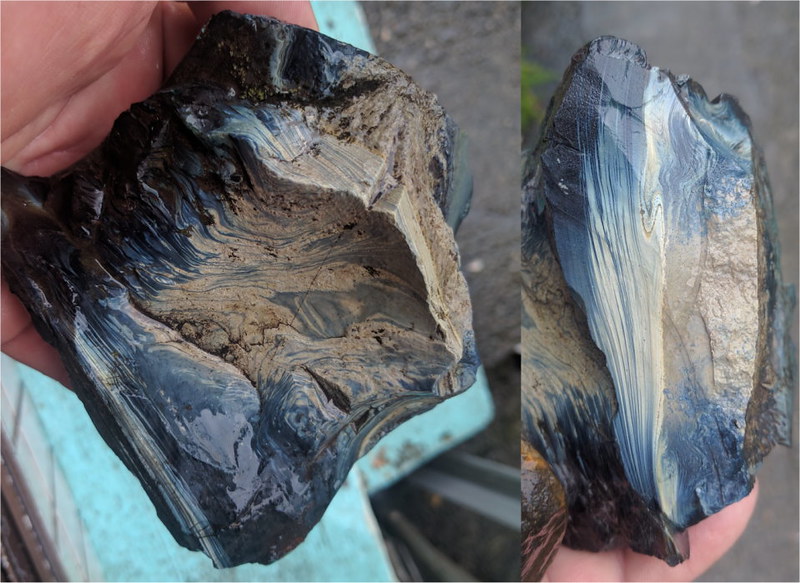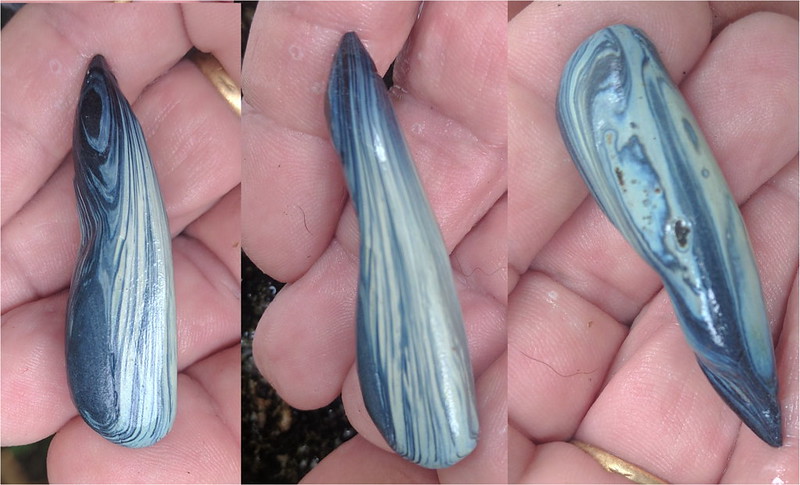|
|
Post by kk on Sept 4, 2017 0:59:59 GMT -5
Most likely slag, but from a very interesting location in England (Bumble Hole), kindly lugged all the way over here by Kelan, a friend of my daughter. Very interesting material. Could be from some smelting foundry in England as the area was an industrial hub for iron and other metal productions from the 1700's onward (Foundries there supplied the chains and ankers for the Titanic). Definitely behaves like glass, breaks and flakes like it, ant is just as annoying to ones fingers. Had several splinters stuck in my hand by the time I had cut the first face. There is also the distant possibility of it being natural and hence obsidian, as the area has been known as a source of minerals usually bordering obsidian. And presence of volcanic activity in the past makes that a possibility too.  ppkelan2 ppkelan2 by Kainzer Kurt, on Flickr Glassy braking surfaces, and a golden sheen coming from under the skin (likely internal fractures).  ppKelan1 ppKelan1 by Kainzer Kurt, on Flickr Tried to get a cut-off to test material, but cant make up my mind which side to use, so turns into a pendant.     ppkelan3 ppkelan3 by Kainzer Kurt, on Flickr Any info on possibilities, will be highly appreciated, Kurt |
|
|
|
Post by kk on Sept 4, 2017 16:50:58 GMT -5
Or is it possible that it is a mixture of things?
Kelan originally was looking for flint as he came across this piece.....
|
|
|
|
Post by Pat on Sept 4, 2017 17:13:36 GMT -5
|
|
|
|
Post by kk on Sept 4, 2017 17:23:57 GMT -5
Will ave to go through it in a while. Sadly all the reference pictures are gone. But on page one, I already saw several names dearly missed from that time. |
|
|
|
Post by Pat on Sept 4, 2017 17:31:05 GMT -5
kk. I've asked Tommy to fix the photos.
|
|
|
|
Post by catmandewe on Sept 4, 2017 17:34:37 GMT -5
Looks just exactly like the slag glass from the smelters in Pennsyvlania, so that would be my guess.
Tony
|
|
|
|
Post by kk on Sept 4, 2017 19:40:10 GMT -5
Confirming my original impression.
I never worked or even held rough obsidian or slag, but somehow despite of absence of visible bubbles within it felt like it would be slag.
Now it would be great to find out what kind of process produces this type of slag.
|
|
|
|
Post by kk on Sept 5, 2017 17:14:54 GMT -5
Looks just exactly like the slag glass from the smelters in Pennsyvlania, so that would be my guess. Tony By any chance, do you know what process creates this kind of slag? What did they smelter in Pennsylvania? |
|
|
|
Post by catmandewe on Sept 6, 2017 9:19:52 GMT -5
Old steel mills, this was the impurities that floated to the top when they smelted it, there were actually mountains of it there.
Tony
|
|
Fossilman
Cave Dweller 
Member since January 2009
Posts: 20,718 
|
Post by Fossilman on Sept 6, 2017 9:23:34 GMT -5
Its slag,but a nice mixture......
|
|